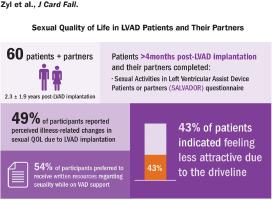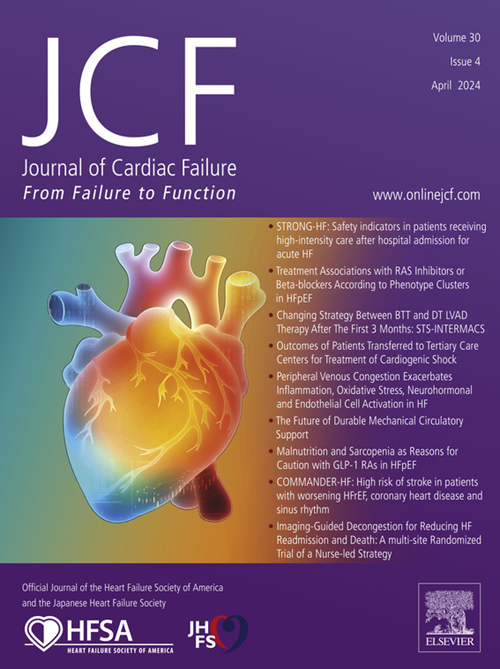左心室辅助装置患者及其伴侣的性生活质量
IF 6.7
2区 医学
Q1 CARDIAC & CARDIOVASCULAR SYSTEMS
引用次数: 0
摘要
导言:与左心室辅助装置(LVAD)一起生活可能会给生活带来负担,例如电池组和装置的传动系统。我们旨在描述与耐用的 LVAD 共同生活对患者及其伴侣的性生活质量(QOL)、抑郁和焦虑的影响:在这项单中心、前瞻性、观察性研究中,植入 LVAD 后≥4 个月的患者及其伴侣填写了左心室辅助装置患者或伴侣性活动(SALVADOR)问卷,以评估他们的性生活质量;填写了 8 个项目的患者健康问卷(PHQ-8),以评估抑郁症状;填写了 7 个项目的广泛性焦虑症(GAD-7),以评估焦虑症状:60 名患者和 60 名伴侣在植入后 2.3 ± 1.9 年完成了问卷调查。87%的患者和13%的伴侣为男性。患者的平均年龄为(57.4 ± 13.3)岁,90%的患者与伴侣同居。10%的患者和18%的伴侣目前被诊断患有心理疾病,其中最常见的是抑郁症和/或焦虑症。总体而言,49% 的参与者表示 LVAD 影响了他们的性活动(患者 53% 对伴侣 45%,P=0.33)。传动系统的干扰是最常见的问题。24%的参与者在PHQ-8中被评为轻度至中度抑郁,28%的参与者在GAD-7中被评为轻度至严重焦虑。患者和伴侣的 GAD-7 总分中位数(1 [0, 4.25] vs. 2.5 [0, 5],p=0.06)相当;而患者的 PHQ-8 总分更高(3 [0, 5.25] vs. 1 [0, 3.25],p=0.02)。54%的参与者表示希望在接受 LVAD 支持时获得性方面的信息,患者和伴侣之间没有差异(P>0.99)。结论:LVAD 严重影响性生活质量:结论:LVAD 严重影响患者及其伴侣的性生活质量。结论:LVAD 严重影响患者及其伴侣的性生活质量。患者更愿意接受有关如何改善性生活质量的书面信息。本文章由计算机程序翻译,如有差异,请以英文原文为准。

Sexual Quality of Life in Left Ventricular Assist Device Patients and Their Partners
Background
Living with a left ventricular assist device (LVAD) comes with potentially burdensome aspects posed by, for example, battery packs and device drivelines. We aim to describe the impact of living with a durable LVAD on sexual quality of life (QOL), depression, and anxiety in patients and their partners.
Methods and Results
In this single-center, prospective, observational study, patients ≥4 months after LVAD implantation and their partners completed the Sexual Activities in Left Ventricular Assist Device Patients or Partners questionnaire to assess their sexual QOL, the 8-item Patient Health Questionnaire (PHQ-8) to assess symptoms of depression and the 7-item Generalized Anxiety Disorder (GAD-7) to assess symptoms of anxiety. Sixty patients and 60 partners completed the questionnaires 2.3 ± 1.9 years after implantation. Eighty-seven percent of the patients and 13% of partners were male. The mean age of patients was 57.4 ± 13.3 years, with 90% living with their partner. Ten percent of patients and 18% of partners had a current diagnosis of a psychological condition, most frequently depression and/or anxiety. Overall, 49% of participants indicated the LVAD influenced their sexual activity (patients 53% vs partners 45%; P = .33). Disturbances from the driveline were the most common problem indicated. Twenty-four percent of participants had scored in the mild to moderate depression range on the PHQ-8 and 28% scored in the mild to severe anxiety range on the GAD-7. The median total GAD-7 (1 [interquartile range (IQR) 0–4.25] vs 2.5 [IQR 0–5]; P = .06) were comparable between patients and partners; whereas patients had a higher total PHQ-8 score (3 [IQR 0–5.25] vs 1 [IQR 0–3.25]; P = .02). A preference to receive information regarding sexuality while on LVAD support was indicated by 54% of participants and did not differ between patients and partners (P > .99). Written resources were the most commonly preferred source of information.
Conclusions
LVADs severely affect the sexual QOL for patients and their partners. The presence of a driveline is a major cause for concern. Patients prefer receiving written information on how to improve their sexual QOL.
求助全文
通过发布文献求助,成功后即可免费获取论文全文。
去求助
来源期刊

Journal of Cardiac Failure
医学-心血管系统
CiteScore
7.80
自引率
8.30%
发文量
653
审稿时长
21 days
期刊介绍:
Journal of Cardiac Failure publishes original, peer-reviewed communications of scientific excellence and review articles on clinical research, basic human studies, animal studies, and bench research with potential clinical applications to heart failure - pathogenesis, etiology, epidemiology, pathophysiological mechanisms, assessment, prevention, and treatment.
 求助内容:
求助内容: 应助结果提醒方式:
应助结果提醒方式:


